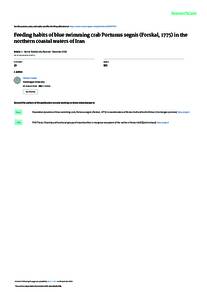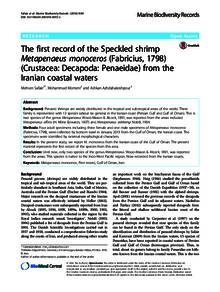وثيقة
Feeding habits of blue swimming crab Portunus segnis (Forskal, 1775) in the northern coastal waters of Iran.
المعرف
DOI: 10.1186/s41200-016-0073-y
الناشر
BioMed Central.
ميلادي
2016-12
اللغة
الأنجليزية
الملخص الإنجليزي
Background: The study of food and feeding habits of crab has manifold importance in fishery sciences. The blue swimming crab Portunus segnis is an opportunistic predator and the diet of which depends on local availability of food items. The distribution and biological aspects of crabs are largely dependent on the availability of preferred prey organisms. Methods: Feeding habits of the blue swimming crab, P. segnis were studied in the northern Persian Gulf by trawl nets during the period from May 2010 to April 2012. The stomach contents of 1722 crabs, ranging from 36 to 175 mm carapace width, were analyzed. Results: The stomach contents appeared to consist of mainly large quantities crustaceans, fish and molluscs, also small quantities of unidentifiable matter and debris. Based on the major food groups were observed in different season, the crustaceans was the most dominant in summer (56 %) and the fish items and Mollusca were the most dominant in autumn (67 %) and winter (45 %) respectively. In Juvenile and sub adult crabs, crustaceans constituted the dominant food source and these were present in 56.7 % and 45.1 % respectively. In the adult groups and larger size groups, fish were the principal food item and these were present in 44.5 % and 53.5 % respectively, of the stomachs analyzed. There were no difference observed in the quantity of the food consumed in both sexes and also significant differences observed in the preference for food items in the different size groups. The crabs without barnacle comparatively voracious with barnacle-carrying crabs. Their diet also increased with increasing ovary stages while that the percentage of empty stomachs in ovigerous females was higher than non-ovigerous females. The C.V. index varied significantly in both sex that was ranged between 6.9- 56.0 % and 16.5- 48.0 % for male and female, respectively. Conclusions: This study shows that, despite the diversity in blue crab diets and feeding habits, there are carnivores with a preference for animal food and the behavior of active predators of sessile and slow-moving macro-invertebrates. It is suggested that a major reduction in availability of one prey group would not have a major effect on the crab population.
المجموعة
ISSN
1755-2672
URL المصدر
قالب العنصر
مقالات الدوريات


